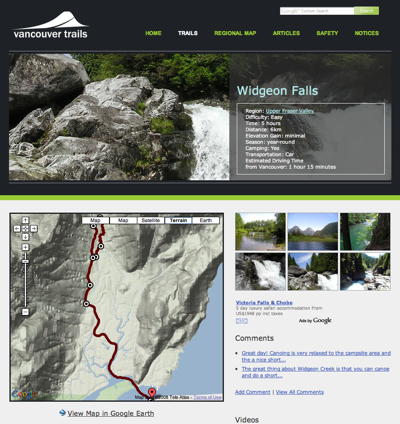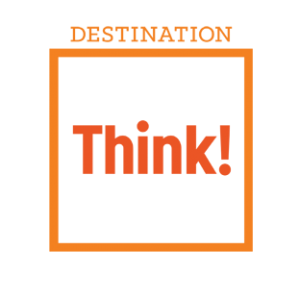May 2008
The Archives
-
Internet, personal
Two Shout Outs
Two friends of mine recently launched some pretty cool websites.

First, Michael Chang, who worked on HelloBC for many years. He is now the owner and operator of El Chango Media launched the new design for Vancouver Trails. This website not only looks gorgeous, it also provides users with tons of information about the plethora of hiking trails around Vancouver.

And second, Dave Wight, who spend many hours cataloging, selecting and manipulating images for HelloBC launched a redesigned website for the Calgary Stampede. I had coffee with him in Calgary a couple of weeks ago when I was there for Online Revealed and I’m happy to hear he’s enjoying his new position and the result shows.
Congratulations guys. -
Internet, Travel & Tourism
What Google is really going to do in the travel space
A blog posting on the Travolution blog about Google and Travel made me think. Is there going to be some big product launch, or will they simply keep connecting the dots?
This BusinessWeek article called “Google’s Travel Plans” is referenced in the posting. Google’s managing director for travel Rob Torres was interviewed. Torres says “the goal of Google’s travel division is to give users a destination where they can research travel plans, read user reviews, and see user uploaded videos and photos.”
The article also states “It’s worth noting one thing that any future Google offering won’t have—airline fares or hotel bookings.” But vertical search is the new disrupter in travel. Kayak.com will perform 45M queries this month according to its CEO, with 5M uniques in April and climbing (compete.com). Microsoft bought Farecast.com to enter into this space.
There’s no way Google will sit back and watch from the sideline. This is search, their core business. They have to make a move into vertical travel search. They won’t need to book anything. They can stay true to their advertising based revenue model, maybe complimented with a Pay-Per-Action model and they won’t alienate their customers or cannibalize their ad based revenue on their main search product.
Torres says in Businessweek “We are already so highly searched for travel. Why not give them a one-stop shop for travel information?”. Vertical Search offers a perfect possibilities to compliment travel information opportunities. The New Zealand campaign on YouTube has been widely covered, but Google Maps is probably even more relevant. Tim Armstrong, Google’s VP of advertising told us at Phocuswright in Orlando last November that “depending on the day, there could be 40% of the traffic to that goes to that service that’s travel related”. That’s huge.
Google is already starting to connect the dots. Google Maps recently integrated photos through Paronamio (a small company it acquired last year), Wikipedia content and YouTube videos. Businesses can also provide Google with their info for display on Google Maps. And the user generated maps cover a lot of tourism content.
A few months ago, Google announced Knol, a Wikipedia for experts. “A knol on a particular topic is meant to be the first thing someone who searches for this topic for the first time will want to read.” Here’s Google’s opportunity to create credible travel content, written by an expert.
Now think about Google’s massive user base of Google accounts, YouTube, Gmail and Orkut. Think about OpenID, Open Social. Think about Friend Connect. Here’s the User Generated Content piece, combined with a social network.
All Google needs to do is keep connecting dots and a strong travel product will evolve and emerge. It might not happen through a big bang approach, but simply as an organic evolution of their existing products. I’m sure there are plenty of Google engineers using their 20% pet-project time to connect dots and creating innovative travel related products. -
Internet, Marketing, personal, tourism bc, Travel & Tourism
Couple of recent panel apperances
05.22.08 | Permalink | 7 CommentsI had the opportunity to join two panel conversations the last few weeks.

The first one was at the Online Revealed conference in Calgary where I joined Terri McCulloch, Tom Wilson,
Jens Thraenhart and Stephen Joyce. Alicia Whalen and Phil Caines did a great job moderating. I particularly like Phil’s live web servicing to show the websites we talked about. This was the third time we took the Tips from the T-List on the road and it was another great session where we discussed and debated the opportunities blogs, User Generated Content and Social Networks provide for the tourism industry. I like these sessions because I represent myself as a travel blogger and Tourism BC for our HelloBC Blogs initiative. It was the first time I met Terri and Tom, and they provided great insights. I’ve been a fan of Terri’s blog for a while now and Tom’s work is a great example of maximizing the medium with limited resources.
Thank you Patricia and Alicia from a Couple of Chicks marketing for inviting me. You’ve done a great job again.

Today I joined Ben Stringfellow (Director of Internal Communications, McDonalds USA), Thierry Hay-Sabourin (Senior Ecommerce Manager, Future Shop), William Azaroff (Interactive Marketing & Channel Manager, Vancity) on a panel called ‘Giving Your Brand Away’ at the Convergence 2008 conference. It was a pleasure to share the stage with this diverse group who’ve all done great things with building communities.
Ben gave us the story and result from a brand new closed community for McDonalds’ staff, reducing cost of printing newletters and creating efficiencies through shared learning between the restaurants. William gave us the remarkable story behind the Change Everything community while Thierry provide insights into Futureshop message boards, including Aaron, the search guy.
The biggest take-away I got from the session was that the first 500 members of your community will set the tone. So it’s important that the first members set the right tone, otherwise it will be hard to recover from that. Thierry shared that the tone on the English boards is very different from the French boards for example. At our HelloBC Blogs, we accidentallyThak did the right thing by starting our efforts with staff and our visitor centres, who set the right tone for consumers. Sometimes you need a bit of luck.
Thank you Sandy from Fjord Interactive for inviting me and a great conference. -
Internet, Management, Travel & Tourism
Kayak CEO Steve Hafner Interview
05.20.08 | Permalink | 4 CommentsExcellent video of an interview PhoCusWright president Philip Wolf conducted with Kayak CEO Steve Hafner during the Travolution Summit. I’m a big fan of Kayak. Both their business model and their Interface are things envy. A must watch for strategists in the travel industry.
My favourite quotes:
About his OTA days: We all build great companies. None were great websites, they don’t search everything, they don’t show you everything. there is a bias in how you display the results, in particular on the Hotel side. Wouldn’t it be interesting to build a website that we wanted to use. And we weren’t biased about what we sold and we would allow you to build supplier direct or agency direct cause that’s what we do as consumers. So as executives, why don’t we build a website like that.
The middle is a mostly PPA, we’ll get a commission or a referral fee.
The next phase is turning Kayak into a vertical ad network.
Our goal is simple. We want to be the number one travel side for consumers information world wide.
Conditions you need for meta search. You need fragmentation in the supplier and agency community. You need a deep penetration of online booking habits. And then you need a vibrant marketplace for monetizing that traffic.
This month we’ll do 45M queries. That more then pricelines, that’s half the size of Orbitz. We do more searches a day then United Airlines.
My observation would just be that Travelocity, Expedia, Orbitz, Kayak; we’re all websites. So the website should be were you put your efforts,; were you innovate. Where you eliminate all the friction for what the consumer wants to do. And I would warrant you that these websites haven’t changed all that much in quite a long time despite having massive human capitol and massive P&L’s.
Travelpost; if you’re going to Tripadvisor its really hard to get to the hotel review. They post lots of impressions and clutter around it. We’re going to fix that.
Our mission statement is: Number one travel site world-wide. Best place for advertisers to market their services. And do it with the lowest operating costs ever seen. We’re going up against Google, we’re going up against Expedia, and we’re doing it with a Craigslist operating philosophy. It’s crazy.
Here we are, 10 years into online travel and buying a simple airline ticket still sucks. We need to fix that part of the equation before we move definitively into the complex travel.
Microsoft is in a tough spot. They’ve gone on record to say they want to compete against Google. They’re not really going to get there with horizontal search so they’ve got a strategy to go vertical search. So they’re assembling the Microsoft Office of vertical search. You’ll see them buy a real estate site, a job site, a travel site, and weave that together into a search volume competitor to Google.
Any place that consumers goto for travel information and that advertisers spend money on is a competitor of ours. Plain and simple.
We’re small or a reason. Not because we can’t hire. We’re small because we want velocity on the website development. I want to continue that innovation stream and beat those other guys at having a great website.
There is a lot of disruption still to come on the user generated content side. If I had to start another company in this space, that’s were I would start. Nobody today has done a great job at integrated user generated reviews with data about rates and availability, what’s a deal, and what’s not, etc.
Thanks for making this available Kevin. -
Internet, Marketing
Micro Interactions + Direct Engagement
Brilliant presentation from David Armano’s Logic+Emotion blog. His concepts of Micro Interactions is extremely appropriate for travel. Through research and observation I’ve learned over the last years that a travel decision is often a result of these small and unexpected interactions. The impact of one or more micro interaction can lead to a travel decision. This can be as simple as a blog entry, a picture on Flickr, or a comment on Twitter.
Seth Godin says: “Conversations among the members of your marketplace happen whether you like it or not. Good marketing encourages the right sort of conversations.” -
Marketing, Travel & Tourism
Marketing your small tourism business in the 21th century: #7: Get your content our there
I posted about the importance of a good website. But you have other options to connect your content with potential visitors. Instead of bringing people to your website, bring your content to the people.
There are plenty of places to do this. Most DMO’s offer a listing program where you can describe your business to potential customers on a dedicated page on their website. A DMO website is a good place to start because this is the place where you can find people who are already expressing interest. At Tourism BC, we offer our HelloBC listing program at TourismBC.net.
And there are other places. Yahoo travel allows you to add your hotel or attraction. Free. Google offers you the ability to provide them information about any business for Google Maps. Free.
There are more places, including dozens of online directories. You don’t have to go crazy because some will be more relevant to your business than others. Some are free, some will charge you. You’ll have to decide for yourself and be careful where you spend your money.
A good rule of thumb is to look at the traffic the website generates and the relevancy to your business. High traffic and high relevancy is where you want to be. But check the content on tourism related websites first. The content should be relevant and accurate.
If you’re charged for a listing, it’s important to measure the results. Directly, by measuring the incoming visitors to your website (available through your website analytics). Or indirectly, by asking your customers where they found out about your business.
At Tourism BC, our listings are very detailed and often a consumer won’t visit an operator website because the information is all there. So we can tell operators how many times the listing was viewed on our websites.
The next logical step is to send your inventory out into the world. This is more complicated and could involve changes to the way you run your business. So we’ll leave that post for a later time.
Previous entries in this series:



